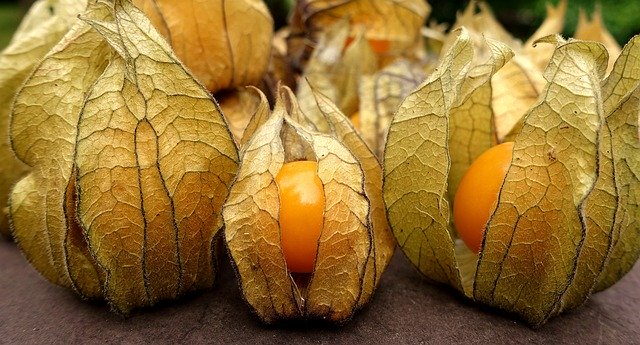
The Cape Gooseberry which is also known as Physalis is that perfectly round orange ball that you find garnishing an entree or salad. It sometimes gets mistaken for a cherry tomato because the two look so similar. Very often though it comes shrouded in a light brown papery husk that reminds me of a chinese lantern. in France, they call is ‘love in cage’ and the children enjoy unwrapping it.
The fruit is grown in South Africa and South America. You can grow garden varieties because of their attractive red lanterns. Starting off as green lanterns, this husk turns a papery, transparent fawn colour when ripe. The internal fruit will have swollen into a bright golden yellow orb. When fully ripe the entire lantern will fall from the plant with the slightest tremor.
The fruit belongs to the Nightshade family or Solanaceae but unlike some of its more toxic family members is safe to eat and comes with plenty of a benefits. the scientific name is Physalis peruviana. It is similar in many ways to its close relative the tomato both in looks and qualities. Whilst the tomato is distinctive in flavour, the cape gooseberry has a slightly tart and acidic flavour.
The fruit is a good source of beta-carotene in particular, vitamin C, iron, calcium and a few B vitamins.
Levels of nutrients, minerals and water-soluble bioactives in Physalis peruviana pulp.
Moisture (g/100 g) 78.9
Protein (g/100 g) 0.05–0.3
Lipid (g/100 g) 0.15–0.2
Carbohydrate (g/100 g) 19.6
Fiber (g/100 g) 4.9
Ash (g/100 g) 1.0
Calcium (mg/100 g) 8.0
Phosphorus (mg/100 g) 55.3
Iron (mg/100 g) 1.2
Carotene (mg/100 g) 1.6
Thiamine (mg/100 g) 0.1
Riboflavin (mg/100 g) 0.03
Niacin (mg/100 g) 1.70
Ascorbic acid (mg/100 g) 43.0
Source: Ramadan and Mörsel (2004).
One of its health benefits is in traditional medicine where it is used as a diuretic. There is no clinical evidence yet to support the claim but many researchers are looking at a host compounds in its near relatives.
How To Eat
Can be eaten on its own, in salads and in desserts. Puddings are a favourite where it serves as an attractive garnish. Many people in Africa and South America use the fruits in confectionary and candy. It is sometimes dried and eaten like a fig.
Growing Cape Gooseberry
Grow from seed in good quality soil.
Sow indoors, 0.5cm (1/4 inch) deep, in rich, well dug soil or in a tray of compost. Water well and place in a warm position. A temperature of 15-20 °C (60-68 °F) is ideal. Keep moist. Seedlings usually appear in 7-21 days. Transplant to individual pots when large enough to handle. Grow on in cooler, but not cold conditions. Plant out to larger pots, growing bags or the greenhouse border.
They grow to about 3 feet in height and make ready hedges at waist-high level. In warm countries, they need no care and do not seem to be affected by pests. they are frost sensitive so in northern and extreme southern climates, need some protection. I start seeds in late winter when I begin the tomatoes. These are planted out early so that the fruits can set and ripen before the end of Autumn. They are perennial so it is possible to keep pot-bound plants in a conservatory and overwinter. I’m told they fruit all year round but this is not common unless living in more tropical climates.
Harvesting the fruit is critical so as to optimize the phenolic content, vitamin C level and antioxidant activity (Bravo et al., 2014).
-
Outdoor Crops
Sow indoors in March or April. Gradually accustom plants to outside conditions but avoid frosts. Plant out 40cm (16″) apart, when frosts are over. Choose a warm, sunny spot. Outdoor crops may ripen later than those in a greenhouse.
Harvesting The Cape Gooseberry
Fruit is ripe when the papery husks dry out and these can be left on the plant until required.
Seeds are acquired from Mr. Fothergills.
In some countries, the plant is viewed as a pernicious weed.
Reference
Bravo, K., Sepulveda‐Ortega, S., Lara‐Guzman, O., Navas‐Arboleda, A. A., & Osorio, E. (2015). Influence of cultivar and ripening time on bioactive compounds and antioxidant properties in Cape gooseberry (Physalis peruviana L.). Journal of the Science of Food and Agriculture, 95(7), pp. 1562-1569 (Article)
Ramadan, M. F. (2011). Bioactive phytochemicals, nutritional value, and functional properties of cape gooseberry (Physalis peruviana): An overview. Food Research International, 44(7), pp. 1830-1836 (Article)
Ramadan, M. F., & Mörsel, J. -T. (2004). Goldenberry: A novel fruit source of fat soluble bioactives. Inform, 15, pp. 130−131
Leave a Reply